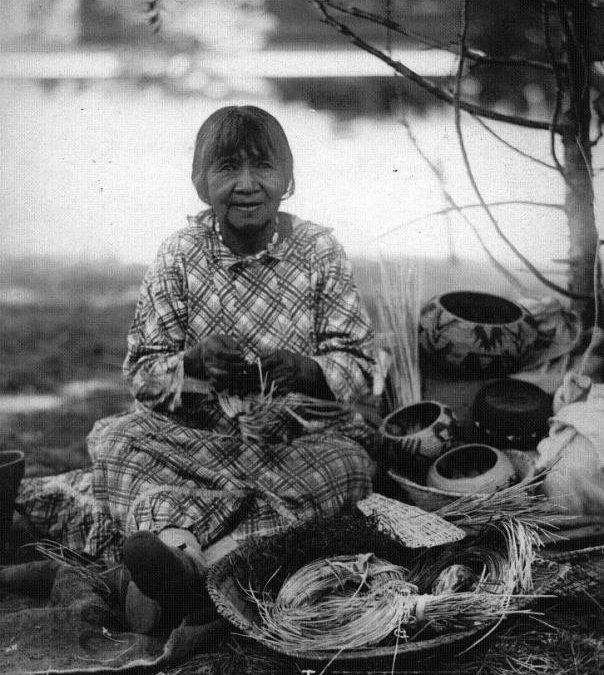I just got back from Yosemite National Park and was curious about its Kickass Women. Happily the National Parks website has a long list of Kickass Women in Yosemite including artists, explorers, rangers, and athletes. I encourage anyone interested to check out this list! For the purposes of this article, I’ve selected Ta-bu-ce, also known as Maggie Howard and as Tabuce. TW for racism, injury, forced removal, genocide, death.
Many details of Ta-bu-ce’s life are unknown, including her birthplace. According to the National Parks Service’s article about her, she was born in either Mono Lake or Bridgeport (both in California), sometime between 1857 and 1870. She was a member of the Paiute tribe. Both of her parents died when she was young. At a very young age, possibly as young as seven, she started working at the Sentinel Hotel in Yosemite Valley.
According to Cowgirl Magazine, Ta-bu-ce and her young niece, May Tom, were caught in a storm in 1899. A tree fell and killed May Tom instantly. Ta-bu-ce had terrible injuries including a broken collarbone and broken bones in her leg, ankle, and feet. These injuries left her with a permanent limp. She decided to make a permanent home in Indian Village in Yosemite National Park.
Allow me to back up here and discuss the history of Native Americans in relation to the park. Yosemite Valley was initially home to the Ahwahneechee tribe. They had close contacts and relationships with surrounding tribes, including the Paiute. This larger conglomeration is known as the Plains and Sierra Miwok. The 1840s – 1870s were the time of the California Genocide, a state-sanctioned and organized genocide against the indigneous peoples of California. The Ahwahneechee resisted invasion during the Mariposa War, which lasted from 1850 – 1851. For more about this part of California’s history, I recommend the book An American Genocide: The United States and the California Indian Catastrophe, 1846-1873 by Benjamin Madley.

In the late 1800s, some tribal members remained in the Yosemite Valley but found their livelihoods threatened by tourism, which depleted the game and other natural resources they needed to survive. The following is from Intermountain Histories:
Yosemite National Park was created in 1890. The Natives were not removed, but their way of life was restricted, and they depended on money from tourism. They sold baskets, charged tourists for photographs, and participated in the Indian Field Days, a showcase of Native American skills, crafts, and games beginning in 1916. Soon after the Field Days began, the Yosemite Indians merged their camps into one village.
In 1929 or 1930, Ta-bu-ce became the first museum docent in the Park. She showed visitors how to gather acorns, make acorn meal, and weave baskets as part of a cultural demonstration project. She also demonstrated how to cook and how to bake bread. She sold baskets, beadwork, and weaving and earned tips for posing for photographs. She was gracious to any who asked her politely, and scathing towards tourists who photographed her without permission.

Cultural demonstrations ended when America entered WWII. In 1942 Ta-bu-ce moved back to Mono Lake. She died in 1947, having been married three times and being survived by two sons. Intermountain Histories states:
In 1953, the park service instituted the Yosemite Indian Village Housing Policy, allowing only permanent government employees to remain in the village. Park officials destroyed the homes of those who left in order to stop newcomers from taking their place, gradually pushing every Native family out of the park. By the 1960s the park service had burned all of the cabins except one, which they converted into a management office. Any remaining Indian workers were moved to park employee housing.
The relationship between the Park and the Indigenous people in their employ was a mixed one. They faced racism from white employees as well as visitors. For instance, the University of Michigan reports:
She sold her work to collectors and visitors and also entered many baskets into the competitions held during Indian Field Days. Indian Field Days were incredibly problematic events in which Ahwahneechees were paid to wear costumes belonging to Plains Indians, and while they were eventually condemned, they were crucial places for basket weavers, mostly women like Tabuce Howard, Lucy Telles, and Carrie Bethel, to make a name for themselves with collectors and generate a livelihood off of their work.

Despite racism, Ta-bu-ce and her companions left an invaluable legacy. The University of Michigan: Women in National Parks has a page about Ta-bu-ce with a lot of photos including photos of Ta-bu-ce and photos of her art. Park workers spoke of her legacy respectfully and fondly, recalling her artistic skills and her skill in handling the public. She was said to be good with a microphone and adept at handling hostile or patronizing tourists.

Despite loss, poverty, chronic pain, and systemic racism, she was able to function with dignity and share real and precious knowledge with others. She was a brilliant artist and a talented educator. Above all, Ta-bu-ce was a survivor.
